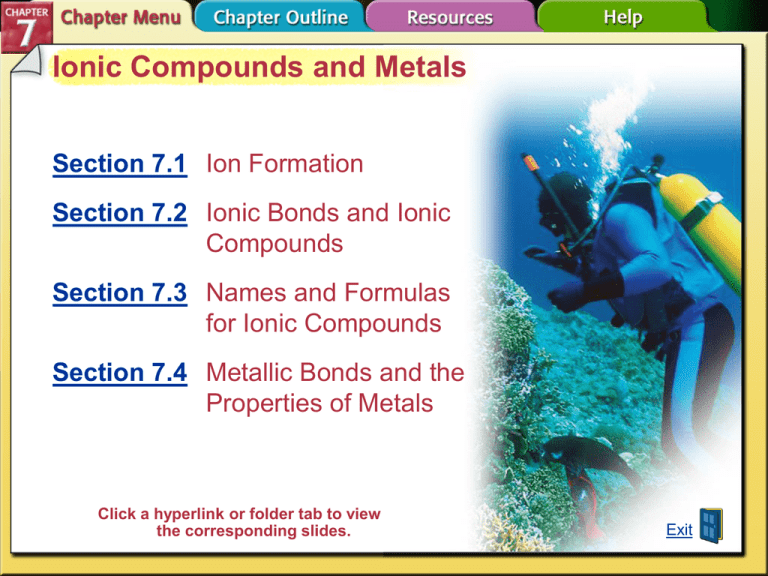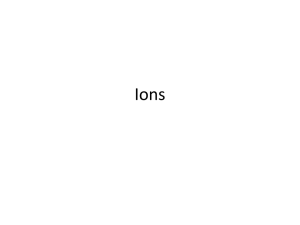Notes 7.1
advertisement

Ionic Compounds and Metals Section 7.1 Ion Formation Section 7.2 Ionic Bonds and Ionic Compounds Section 7.3 Names and Formulas for Ionic Compounds Section 7.4 Metallic Bonds and the Properties of Metals Click a hyperlink or folder tab to view the corresponding slides. Exit Section 7.1 Ion Formation • Define a chemical bond. • Describe the formation of positive and negative ions. • Relate ion formation to electron configuration. octet rule: atoms tend to gain, lose, or share electrons in order to acquire eight valence electrons chemical bond cation anion Ions are formed when atoms gain or lose valence electrons to achieve a stable octet electron configuration. Valence Electrons and Chemical Bonds • A chemical bond is the force that holds two atoms together. • Chemical bonds form by the attraction between the positive nucleus of one atom and the negative electrons of another atom. • They can also form by the attraction between positive and negative ions. Valence electrons are the outer shell electrons of an atom. The valence electrons are the electrons that participate in chemical bonding. Group 1 2 13 14 15 16 17 e- configuration # of valence ens1 1 ns2 2 ns2np1 ns2np2 3 4 ns2np3 5 ns2np4 6 ns2np5 7 Valence Electrons and Chemical Bonds (cont.) • Atom’s try to form an octet — the stable arrangement of eight valence electrons in the outer energy level— by gaining or losing valence electrons. • Noble gases are unreactive because they have a filled valence shell. – If sodium (element 11) were to lose one valence electron, its electron configuration would be like neon. – They would both have 10 electrons – The number of protons, however, would still be different. • Na = 11 protons • Ne = 10 protons • Elements want to obtain the same number of electrons as the closest Noble Gas • SO… – Metals and Hydrogen tend to lose electrons to achieve the same number of electrons as a noble gas (POSITIVE IONS + = CATIONS) – Nonmetals tend to gain electrons to achieve the same number of electrons as a noble gas (NEGATIVE IONS = ANIONS) Positive Ion Formation *Positive ions form when an atom loses one or more valence electrons. • A positively charged ion is called a cation. • The number of Protons does not change Positive Ion Formation (cont.) • Metals are reactive because they lose valence electrons easily. Positive Ion Formation (cont.) • Transition metals commonly form 2+ or 3+ ions, but can form greater than 3+ ions. • Other relatively stable electron arrangements are referred to as pseudo-noble gas configurations. Negative Ion Formation •Negative ions form when an atom gains one or more valence electrons. • An anion is a negatively charged ion. •The number of Protons does not change Negative Ion Formation (cont.) • Nonmetal ions gain the number of electrons required to fill an octet. • Some nonmetals can gain or lose electrons to complete an octet. • Group 1 elements = +1 ions • Group 2 elements = +2 ions • Groups 3-12 elements = more than one charge (all positive) typically +2,+3,+4 • Group 13 elements = +3 ions (B, Al, Ga, In and Tl) • Group 14 elements can be +4, -4, or 0. C and Si usually 0, Ge, Sn, and Pb +2 or +4 • Group 15 elements of N, P, and As are -3 ions, Sb and Bi are usually (+ ions) • Group 16 elements of O, S, Se, Te are -2 ions • Group 17 elements = -1 ions all of them • Group 18 element = 0 charge = Noble gases (not reactive) • For each ion, give the number of protons, electrons and what group they belong to. • Se-2 protons electrons group • Sr+2 protons electrons group Section 7.1 Assessment Oxygen gains two electrons to form what kind of ion? A. 1– anion B. 2– anion D A 0% C D. 2+ cation A. A B. B C. C 0% 0% 0% D. D B C. 1+ cation Section 7.1 Assessment Elements with a full octet have which configuration? A. ionic configuration B. halogen configuration D A 0% C D. transition metal configuration A. A B. B C. C 0% 0% 0% D. D B C. noble gas configuration








